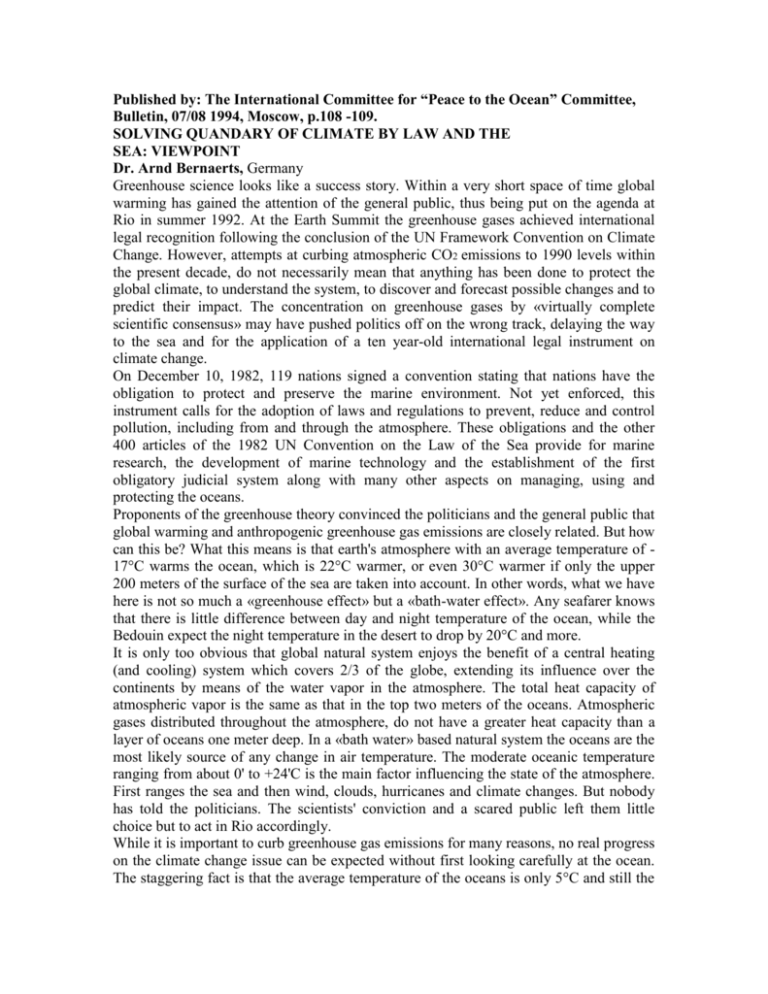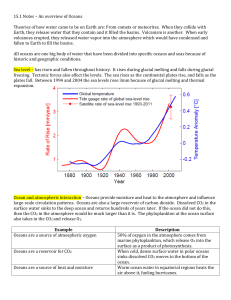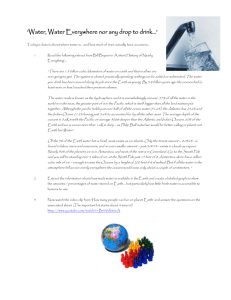Published by: The International Committee for “Peace to the Ocean
advertisement

Published by: The International Committee for “Peace to the Ocean” Committee, Bulletin, 07/08 1994, Moscow, p.108 -109. SOLVING QUANDARY OF CLIMATE BY LAW AND THE SEA: VIEWPOINT Dr. Arnd Bernaerts, Germany Greenhouse science looks like a success story. Within a very short space of time global warming has gained the attention of the general public, thus being put on the agenda at Rio in summer 1992. At the Earth Summit the greenhouse gases achieved international legal recognition following the conclusion of the UN Framework Convention on Climate Change. However, attempts at curbing atmospheric CO2 emissions to 1990 levels within the present decade, do not necessarily mean that anything has been done to protect the global climate, to understand the system, to discover and forecast possible changes and to predict their impact. The concentration on greenhouse gases by «virtually complete scientific consensus» may have pushed politics off on the wrong track, delaying the way to the sea and for the application of a ten year-old international legal instrument on climate change. On December 10, 1982, 119 nations signed a convention stating that nations have the obligation to protect and preserve the marine environment. Not yet enforced, this instrument calls for the adoption of laws and regulations to prevent, reduce and control pollution, including from and through the atmosphere. These obligations and the other 400 articles of the 1982 UN Convention on the Law of the Sea provide for marine research, the development of marine technology and the establishment of the first obligatory judicial system along with many other aspects on managing, using and protecting the oceans. Proponents of the greenhouse theory convinced the politicians and the general public that global warming and anthropogenic greenhouse gas emissions are closely related. But how can this be? What this means is that earth's atmosphere with an average temperature of 17°C warms the ocean, which is 22°C warmer, or even 30°C warmer if only the upper 200 meters of the surface of the sea are taken into account. In other words, what we have here is not so much a «greenhouse effect» but a «bath-water effect». Any seafarer knows that there is little difference between day and night temperature of the ocean, while the Bedouin expect the night temperature in the desert to drop by 20°C and more. It is only too obvious that global natural system enjoys the benefit of a central heating (and cooling) system which covers 2/3 of the globe, extending its influence over the continents by means of the water vapor in the atmosphere. The total heat capacity of atmospheric vapor is the same as that in the top two meters of the oceans. Atmospheric gases distributed throughout the atmosphere, do not have a greater heat capacity than a layer of oceans one meter deep. In a «bath water» based natural system the oceans are the most likely source of any change in air temperature. The moderate oceanic temperature ranging from about 0' to +24'C is the main factor influencing the state of the atmosphere. First ranges the sea and then wind, clouds, hurricanes and climate changes. But nobody has told the politicians. The scientists' conviction and a scared public left them little choice but to act in Rio accordingly. While it is important to curb greenhouse gas emissions for many reasons, no real progress on the climate change issue can be expected without first looking carefully at the ocean. The staggering fact is that the average temperature of the oceans is only 5°C and still the oceans hold almost one thousand times more heat than the whole atmosphere. A minor change in ocean currents and temperature has an immediate and inevitable impact on the climate. Due to the huge masses of water in the oceans and its heat capacity, climate and the state of the oceans are coupled in a way by which the global climate follows the ocean pattern, thus it can be said, climate is the continuation of the oceans by other means. Yet, the common definition of climate is expressed as the average weather over a substantial period of time. After all, the main factors of climate, water and heat, the oceans are a thousand and more times bigger than all the non-vapor greenhouse gases put together. In actual fact, only ocean water makes the earth a «warm» planet as otherwise a permanently dark earth would have a temperature close to minus 242°C and even with daily sunshine the average temperature would not rise above –ll°C (day: +130°C; night: 150°C) instead of the lower air surface temperature of +14°C. Only the bath-water effect of the oceans ensures our moderate average temperature. If meteorologists had pushed for means to observe thoroughly the activities of the oceans since Krakatoa, weather and weather forecasts would not contradict each other. But they never did. To discover the secrets of the controlling mechanism, reasons for any changes and their possible impact on climate, the oceans can be used as a magnifying glass on what is happening in the natural global system and the 1982 UN Convention on the Law of the Sea is the master plan for organizing the monitoring and understanding of the sea as well as the mechanism of climate. The Convention is a strong instrument forcing all states to contribute their share. The struggle to draft the Rio Climate Change Convention indicates that it would be most unlikely that the community of states could today agree on principles and concepts comparable to the 1982 Convention. In comparison the Rio Convention on Climate Change aims at the stabilization of greenhouse gas concentration in the atmosphere at a level that would prevent dangerous anthropogenic interference with the climate system. A questionable cause is now internationally established although the climatic system itself is barely understood. The path laid in Rio is likely to distract attention from more serious anthropogenic causes for climatic changes. The result is that efforts and resources will be concentrated on CO2 for the time being. A master plan has been available for ten years for decisive actions needed to understand and protect the supreme factor of the earth's ecological balance. Ignoring the oceans, the proponents of the greenhouse theory have failed to appreciate the real nature of climate and to consider whether there was a rise of sea temperature (and sea level) first. To avoid uncertainties, the 1982 UN Convention on the Law of the Sea needs to be applied immediately. It would require all nations to commit themselves to the ecological cause, improve the protection of the sea, and form the breeding ground for true climatologists.








